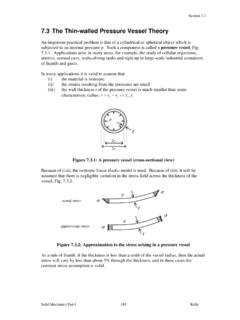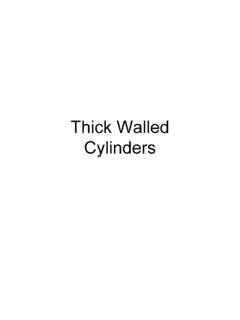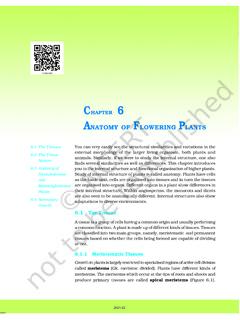Transcription of PRESSURE VESSELS - MIT
1 PRESSUREVESSELSD avid RoylanceDepartment of Materials Science and EngineeringMassachusetts Institute of TechnologyCambridge, MA 02139 August 23, 2001 IntroductionA good deal of the Mechanics of Materials can be introduced entirely within the confines ofuniaxially stressed structural elements, and this was the goal of the previous modules. But ofcourse the real world is three-dimensional, and we need to extend these concepts now take the next step, and consider those structures in which the loading is still simple, butwhere the stresses and strains now require a second dimension for their description. Both fortheir value in demonstrating two-dimensional effects and also for their practical use in mechanicaldesign, we turn to a slightly more complicated structural type: the thin - walled PRESSURE such as pipes or bottles capable of holding internal PRESSURE have been veryimportant in the history of science and technology.
2 Although the ancient Romans had developedmunicipal engineering to a high order in many ways, the very need for their impressive systemof large aqueducts for carrying water was due to their not yet having pipes that could maintaininternal PRESSURE . Watercanflow uphill when driven by the hydraulic PRESSURE of the reservoirat a higher elevation, but without a PRESSURE -containing pipe an aqueduct must be constructedso the water can run downhill all the way from the reservoir to the cabins are another familiar example of PRESSURE -containing structures. They illus-trate very dramatically the importance of proper design, since the atmosphere in the cabin hasenough energy associated with its relative pressurization compared to the thin air outside thatcatastrophic crack growth is a real possibility.
3 A number of fatal commercial tragedies haveresulted from this, particularly famous ones being the Comet aircraft that disintegrated in flightin the 1950 s1and the loss of a 5-meter section of the roof in the first-class section of an AlohaAirlines B737 in April 19882In the sections to follow, we will outline the means of determining stresses and deformationsin structures such as these, since this is a vital first step in designing against two dimensions, the state of stress at a point is conveniently illustrated by drawing fourperpendicular lines that we can view as representing four adjacent planes of atoms taken froman arbitrary position within the material. The planes on this stress square shown in Fig. 1 canbe identified by the orientations of their normals; the upper horizontal plane is a +yplane, since1T.
4 Bishop, Fatigue and the Comet Disasters, Metal Progress,Vol. 67, pp. 79 85, May Murphy, Aging Aircraft: Too Old to Fly? IEEE Spectrum,pp. 28 31, June normal points in the +ydirection. The vertical plane on the right is a +xplane. Similarly,the left vertical and lower horizontal planes are yand x, 1: State of stress in two dimensions: the stress sign convention in common use regards tensile stresses as positive and compressivestresses as negative. A positive tensile stress acting in thexdirection is drawn on the +xfaceas an arrow pointed in the +xdirection. But for the stress square to be in equilibrium, thisarrow must be balanced by another acting on the xface and pointed in the xdirection. Ofcourse, these are not two separate stresses, but simply indicate the stress state is one of uniaxialtension.
5 A positive stress is therefore indicated by a + arrow on a + face, or a arrow on a face. Compressive stresses are the reverse: a arrow on a + face or a + arrow on a face. Astress state with both positive and negative components is shown in Fig. 2: The sign convention for normal now a simple spherical vessel of radiusrand wall thicknessb, such as a roundballoon. An internal pressurepinduces equal biaxial tangential tensile stresses in the walls,which can be denoted using sphericalr coordinates as and .Figure 3: Wall stresses in a spherical PRESSURE magnitude of these stresses can be determined by considering a free body diagram ofhalf the PRESSURE vessel , including its pressurized internal fluid (see Fig. 3). The fluid itself isassumed to have negligible weight.
6 The internal PRESSURE generates a force ofpA=p( r2)actingon the fluid, which is balanced by the force obtained by multiplying the wall stress times itsarea, (2 rb). Equating these:p( r2)= (2 rb)2 =pr2b(1)Note that this is a statically determined result, with no dependence on the material , note that the stresses in any two orthogonal circumferential directions are the same; = .The accuracy of this result depends on the vessel being thin - walled , of the vessel wall, a radial stress rmust be present to balance the PRESSURE there. Butthe inner-surface radial stress is equal top, while the circumferential stresses areptimes theratio (r/2b). When this ratio is large, the radial stresses can be neglected in comparison withthe circumferential 4: Free-body diagram for axial stress in a closed-end stresses zin the axial direction of a cylindrical PRESSURE vessel with closed ends arefound using this same approach as seen in Fig.
7 4, and yielding the same answer:p( r2)= z(2 r)b z=pr2b(2)Figure 5: Hoop stresses in a cylindrical PRESSURE , a different view is needed to obtain the circumferential or hoop stresses .Considering an axial section of unit length, the force balance for Fig. 5 gives2 (b 1) =p(2r 1) =prb(3)Note the hoop stresses are twice the axial stresses. This result different stresses in differ-ent directions occurs more often than not in engineering structures, and shows one of the3compelling advantages for engineered materials that can be made stronger in one direction thananother (the property ofanisotropy). If a PRESSURE vessel constructed of conventional isotropicmaterial is made thick enough to keep the hoop stresses below yield, it will be twice as strongas it needs to be in the axial direction.
8 In applications placing a premium on weight this maywell be something to 1 Figure 6: Filament-wound cylindrical PRESSURE a cylindrical PRESSURE vessel to be constructed byfilamentwinding,in which fibers are laiddown at a prescribed helical angle (see Fig. 6). Taking a free body of unit axial dimension along whichnfibers transmitting tensionTare present, the circumferential distance cut by these samenfibers isthen tan . To balance the hoop and axial stresses, the fiber tensions must satisfy the relationshoop :nTsin =prb(1)(b)axial :nTcos =pr2b(tan )(b)Dividing the first of these expressions by the second and rearranging, we havetan2 =2, = This is the magic angle for filament wound VESSELS , at which the fibers are inclined just enough to-ward the circumferential direction to make the vessel twice as strong circumferentially as it is hoses are also braided at this same angle, since otherwise the nozzle would jump forward orbackward when the valve is opened and the fibers try to align themselves along the correct.
9 ThePoissoneffectWhen a PRESSURE vessel has open ends, such as with a pipe connecting one chamber with another,there will be no axial stress since there are no end caps for the fluid to push against. Then onlythe hoop stress =pr/bexists, and the corresponding hoop strain is given by Hooke s Law as: = E=prbESince this strain is the change in circumference Cdivided by the original circumferenceC=2 rwe can write: C=C =2 rprbE4 The change in circumference and the corresponding change in radius rare related by r= C/2 , so the radial expansion is: r=pr2bE(4)This is analogous to the expression =PL/AEfor the elongation of a uniaxial tensile 2 Consider acompoundcylinder,one having a cylinder of brass fitted snugly inside another of steel asshown in Fig. 7 and subjected to an internal PRESSURE ofp= 7: A compound PRESSURE the PRESSURE is put inside the inner cylinder, it will naturally try to expand.
10 But the outercylinder pushes back so as to limit this expansion, and a contact PRESSURE pcdevelops at the interfacebetween the two cylinders. The inner cylinder now expands according to the differencep pc, whilethe outer cylinder expands as demanded bypcalone. But since the two cylinders are obviously going toremain in contact, it should be clear that the radial expansions of the inner and outer cylinders must bethe same, and we can write b= s (p pc)r2bEbbb=pcr2sEsbswhere theaandssubscripts refer to the brass and steel cylinders numerical values and solving for the unknown contact pressurepc:pc= 976 KPaNow knowingpc, we can calculate the radial expansions and the stresses if desired. For instance, thehoop stress in the inner brass cylinder is ,b=(p pc)rbbb= MPa (= 906 psi)Note that the stress is no longer independent of the material properties (EbandEs), depending as itdoes on the contact pressurepcwhich in turn depends on the material stiffnesses.














